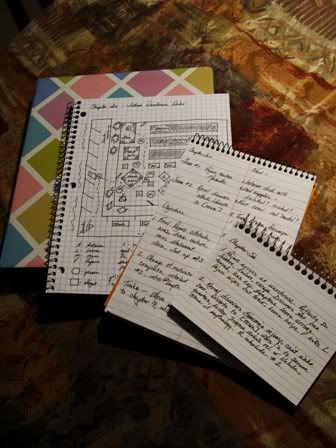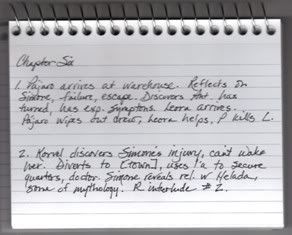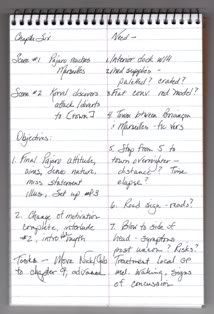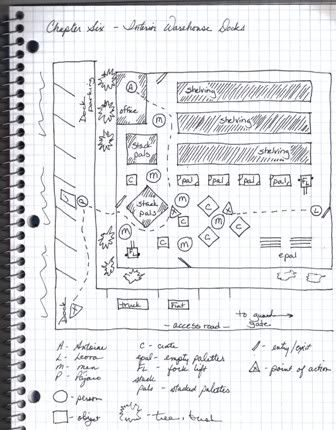 While I do love the convenience and efficiency of technology, as a writer I don't think I'll ever trust it. I am ruthless about backing up my work, which improves the odds of avoiding technology-created problems, but at least once a year I still lose something. No matter how careful I am, all it takes is one power outage during a work session and hours of work can go poof. And the problem isn't mine alone -- ask any writer, and I bet they have stories about files becoming corrupted, programs glitches sending a manuscript to NeverGetItBackLand and the ultimate horror, a complete hard drive melt down.
While I do love the convenience and efficiency of technology, as a writer I don't think I'll ever trust it. I am ruthless about backing up my work, which improves the odds of avoiding technology-created problems, but at least once a year I still lose something. No matter how careful I am, all it takes is one power outage during a work session and hours of work can go poof. And the problem isn't mine alone -- ask any writer, and I bet they have stories about files becoming corrupted, programs glitches sending a manuscript to NeverGetItBackLand and the ultimate horror, a complete hard drive melt down.The rapid advancement of technology also has another, built-in problem for writers who have been in the game for longer than a few years: it renders older technology obsolete and unusable, and by extension, anything you used them to create. Sure, I have multiple copies of every book I've ever written backed up and saved. About a fourth of those backups are now unusable because my current writing software can't convert the old file formats from the programs I used in the past. If ever decided to reprint my old Gena Hale romances, for example, I'd have to either retype the manuscripts or scan each page from my old hard copies and digitally convert them.
There are all kinds of new tech solutions to old tech problems, but sometimes technology simply interferes too much with my writing process for me to use it. Like note-taking. I could keep notes on the computer in some form or another and multi-task between documents or programs while writing. The thing is, I don't like jumping from one window to another when I'm writing; it destroys my rhythm and my momentum. I also like to be able to look at my story notes while I'm actively writing. This is why I still keep my notes in some hard copy form on my work station. I also like playing with office supplies, so over the years I've come up with some interesting, no-tech ways to manage the notes I use while writing:
 Chapter Summary Deck
Chapter Summary DeckI admit, I've never been a huge fan of index cards. Because they're loose they're easy to shuffle out of order or misplace; they're really too small to contain much info, the only way to hold them together was by rubberbanding them, and a stack is usually too bulky to comfortable stow in the binder pocket of my novel notebook.
After years of working straight from a printed copy of a synopsis, I started experimenting with ways to break down a novel into brief chapter summaries. I tried small notepads, sticky notes and then decided to look at index cards again. That was when I discovered spiral-bound index cards. While the lines are still too narrow, binding the index cards into a deck solved all the other problems I had with them. When I'm finished, I simply hook the deck's spiral binding through the top clip of my novel notebook binder, which keeps it neatly in place.
Now I'm constantly finding new ways to use spiral-bound index cards: as character stat indexes, series mini-encyclopedias (when you invent an entire new universe, just trying to keep tracking of the names of all the different worlds can be a real headache), personal style Bibles and more.
 Steno Noting
Steno NotingWhen I was a kid I never had enough paper to write on, and since new paper was too expensive to constantly buy, my mom got me into recycling used paper long before it was fashionable. My favorite recycled paper to use was the back of the pages in one of Mom's old steno pads. Instead of throwing them away when they were used up, she would bring them home from work and give them to me. Because she only wrote on one side of the pages, I'd just flip the book over and write my poems on the blank sides. I loved that red line running down the center of the page because I'd write my poem on the left side of the line and then use the right side to jot down alternative words and phrase ideas when I edited the poem.
I still use steno pads, which I buy new by the dozen from the local dollar store. Those two-column pages are great for writing everything from pro and con lists to character comparisons. When I'm working on a novel, I jot down my chapter objectives on the left side and while I'm writing make notes about things I need to find out, check in my research notes or otherwise redo during my daily editing session.
Steno pads also serve as excellent checklists (put your items on one side, and check off or date when you complete them on the other); daily quota tally sheets (list your dates and daily totals on the left and your running monthly total on the right) and even a simple planner for your week (days of the week on the left, lists of what you plan to do each day on the right.) Steno pads are also wonderful for compiling lists of title ideas, because you can run a column of ideas down one side and then jot some variations of the idea beside them.
 Graph Paper Mapping
Graph Paper MappingMany writers are insanely talented map makers and floor-plan creators, and a few rank right up there with professional cartographers and architects. Sadly, I am not one of these gifted folks. Using freehand, I couldn't map my way out of a 5X5 square cardboard box. Whenever I desperately needed to lay out a fictional location or make up a floor plan so I could choreograph a scene, I had to rely on what was in my head, or draw something that looked like driving directions an inebriated dyslexic had penned in complete darkness in felt-tip on a cocktail napkin.
Graph paper finally came to my rescue (via my quilting, no less.) Whenever I design a pattern for a patchwork quilt, I use graph paper because the little squares help keep my lines straight, and are easy to count when I'm trying to figure out proportions. After screwing up yet another hand-drawn blue print of a fictional location, in frustration I pulled out a graph paper pad to work on a quilt pattern design. At last the light bulb went on and I tried drawing my floor plan again, this time thinking about the design the same way I did a quilt block and using the squares on the graph paper as a line guide and an area mapper. Worked fabulously for me, and now I use graph paper for everything I map out.
Have you come up with any no-tech and/or non-tradition ways to manage your notes? Share your tips in comments.

I think my favorite note taking tool is a big white board. I write quotes the characters use or work out plot reminders for the book I’m working on.
ReplyDeleteI actually have 4 white boards up, :)
My second most used whiteboard is marked into boxes, I write the name of each book I’ve written and mark if it's a single, double or trilogy. I stuck a sticky index card in each box where I wrote all the names of the main characters and the word count. I find I want to reuse names and have to really keep an eye out for that.
I wonder if most writers have a love of paper? I call it an addiction. :)
Thanks for the blog posts I enjoy reading them.
As a writer in the younger, technology driven generation, I also still have a love for things I can touch. For example, one piece of advice I was given was to make a spreadsheet of scenes. I couldn't do it. I'm a whiz at spreadsheets, but somehow typing them in just made it too impersonal.
ReplyDeleteInstead, I used different colored notecards to map my story out on a bulletin board. http://eawestwriting.blogspot.com/2011/03/day-2-story-board-complete.html
I'm still struggling with my character sheets. I have a few notes here and there, but nothing like your character color palettes (which I did try, and they kinda helped) and I don't know what my solution will be. I've considered using 4x6 notecards with a picture of the character and all of their information and laminating it. I think that's a lot of work.
At this point, I think I'm going to finish my first draft, THEN make more detailed character sketches and keep those in mind as I polish and edit. Right now, I just feel like I need to get the story out.
Thanks for this, PBW! I, too, love steno pads ... and never thought to look for them at the dollar store. What a great tip!
ReplyDeleteAlready planning a trip over to DollarTree this afternoon - though I must admit, I love using index cards and buy cool little envelopes in different colors (good for color coding) to keep them in. DollarTree is a great place for index cards. I'll be stocking up on them, too, today.
Thanks so much!
I love these ideas. I have binders - ones with clear fronts that I can insert artwork into. I don't know that I've even come up with a fraction of the ways they can be used, but after losing links to favorite reference websites more than once, I've become more inclined to copy information I may need into an electronic file, or print it if it's small. It goes into the notebook, along with pictures that remind me of my characters or settings, and all my prewriting, and I can add or move things around, or take it all out and spread it out on the table if I'm stuck and need to go back and re-trace my steps.
ReplyDeleteJulieB
Wow these are some fantastic ideas! You are so organized, Lynn, I love it!! :)
ReplyDeleteI love the idea of Steno Noting as well as Graph Paper Mapping since I am a very visual and "listy" person. I'm going to have to try this sometime!
~TRA
http://xtheredangelx.blogspot.com
I love notebooks. I use several different kind for different applications. See my post on this topic at http://dwaynephillips.net/workingup/2009/02/notebooks/
ReplyDeleteMy question is how to convert these to digital. I want to scan my notebooks, but my home scanner would take years to do this.
Anyone know of where I can get my notebooks scanned for a penny a page?
Dwayne,
ReplyDeleteI don't know if this would work for your notebooks, but a couple of months back I faced a similar problem with a buncha notes ... and rather than scan them, I dictated them into a new Word document via Dragon (thx again to PBW, I learned about Dragon Naturally Speaking here on this blog).
Not only was this faster than scanning the stuff, it helped me cull unnecessaries and get stuff in my head. I plan on doing this again, when needed.
Hope this helps.
I've recently started using 4x6 index cards and a $2 photo brag book to organize my scene notes.
ReplyDeleteI always hated index cards because of the reasons you posted, but I also couldn't stand spiral index card books, because sometimes I do need to change the order of things, especially when I start to revise -- a process for me that often requires fine tuning the order of scenes.
The brag book allows me to pop cards in and later pull them out to rearrange, and it also fits in my purse. Because I broke the notes down by scene rather than chapter, I actually have several brag books for a novel-length project.
Yup, a day late again! Or two. Or three...
ReplyDelete*sigh*
This has been some rough weeks. But I wanted to say that I use a letter sized graph paper notebook and those tiny post its. The ones that are half sized. In different colors. On the right hand page, I'll have my picture or character idea or what have you and on the left page, I have post its with all of the tiny scenes for that section. Gives me a chance to move things around and play without a lot of erasing and such.
And OneNote. I don't know what I'd do without that! All of my hardcopy notes and research goes in that. I have 'notebooks' for each story, each notebook has folders and pages and subpages. And I can highlight things I find for a story on the web and right-click them into OneNote without having to copy/paste all the time.
Love this post! I included it in my weekly blog roundup: http://www.smreine.com/2011/04/saturday-round-up_09.html
ReplyDeleteI can't let myself make maps very often, because I won't write at all. It's really too bad I don't make that much use of my floor plans, but I do have a world map that's come in handy.
ReplyDeleteI'm working my way backwards through your posts. I love the idea of spiral-bound index cards. I've seen them in the drugstore, but never gave them much thought. One for each novel I'm working on would help keep the little-bits-of-notes chaos down. Off to the drugstore!
ReplyDelete